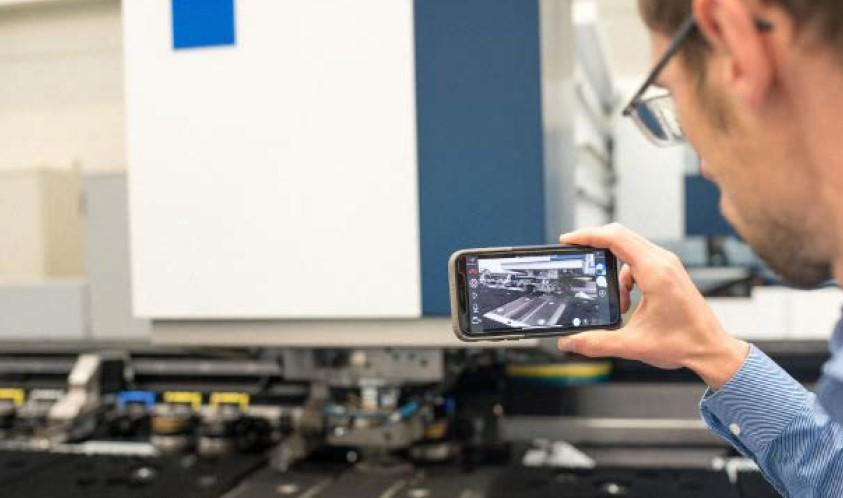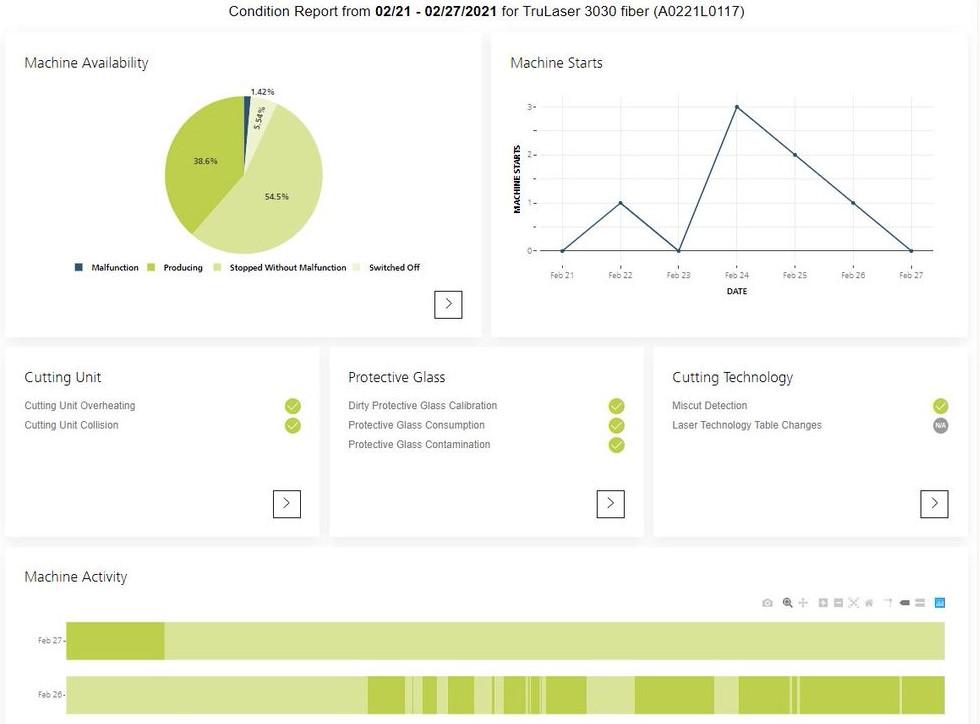Head of Smart Services
- FMA
- The Fabricator
- FABTECH
- Canadian Metalworking
Categories
- Additive Manufacturing
- Aluminum Welding
- Arc Welding
- Assembly and Joining
- Automation and Robotics
- Bending and Forming
- Consumables
- Cutting and Weld Prep
- Electric Vehicles
- En Español
- Finishing
- Hydroforming
- Laser Cutting
- Laser Welding
- Machining
- Manufacturing Software
- Materials Handling
- Metals/Materials
- Oxyfuel Cutting
- Plasma Cutting
- Power Tools
- Punching and Other Holemaking
- Roll Forming
- Safety
- Sawing
- Shearing
- Shop Management
- Testing and Measuring
- Tube and Pipe Fabrication
- Tube and Pipe Production
- Waterjet Cutting
Industry Directory
Webcasts
Podcasts
FAB 40
Advertise
Subscribe
Account Login
Search
Attaining zero unplanned downtime in metal fabrication
How data analytics will transform maintenance in smart manufacturing settings
- By Claire Gregoire and Heidi-Melanie Maier
- May 18, 2021
- Article
- Manufacturing Software

The smartphone, along with smart glasses and other tools, has boosted the potential of remote diagnostics. Images: TRUMPF Inc.
When fabricators invest in new equipment, they are looking to increase their production capacity or their technical capabilities—and these requirements drive the buying decision. The convenience of managing equipment availability has yet to become a major selling point, as it used to be driven by the knowledge and experience of its operators and maintenance team.
With the rise of the internet of things, more and more manufacturers see the potential of managing machine reliability digitally, increasing the convenience of service, and supporting 24/7 unmanned shift operations. As a consequence, they are changing their methods and tools for equipment maintenance. Their goal: zero unplanned downtime.
For years preventive maintenance has been the industry standard. It is all guided by time intervals: Change the laser cutting head’s protective glass every four weeks; perform a full maintenance routine every six months. For a single machine, the schedule is simple to calculate, understand, and plan, be it on a shop floor whiteboard or with the help of a digital production plan.
However, machines require different components at different time intervals, and these depend on cutting parameters and machine utilization. Defining time intervals on a large shop floor with a variety of machines and different usages can quickly become a complex undertaking. For the fabricator, the process takes experience, continuity in staff, and attention to detail that might get lost in the daily hustle of short lead times and fast-changing customer requirements. Increasingly, manufacturers are adapting their maintenance services based on data collected from the machine.
The Prerequisite: Connectivity
It all starts with data connectivity of individual machines. The continuous transfer of equipment information to the service organization creates a digital twin of each machine, its performance, and its life cycle development. Of course, this data becomes useful only if the service organization has the right tools to manage and interpret it.
Data Visualization
Data sets need to be presented in ways that can be interpreted. Hence, data visualization is key. OEMs need smart and powerful IT systems to simplify information for machine owners and service personnel so they can make the right decisions at any given moment.
Data indicators can help to improve the operation. For instance, some indicators can help the machine avoid cutting-unit collisions in certain situations. And the specifics matter. For instance, indicators can give insight into what is happening at a specific time of the day, on a specific program, using specific parameters. Such insights can not only reduce downtime, but also increase equipment productivity. At this level, any machine issue becomes transparent but still requires decision-making and effort to make the appropriate corrections aimed at preventing downtime.
Data-driven Recommendations and Predictions
Instead of just looking at each machine, data engines look at whole populations of equipment, recognize patterns that statistically lead to downtime within that population, and recommend the right actions. This requires a high quantity of data and deep knowledge when analyzing it.
The system itself then can recommend action items, such as when a certain maintenance step is required or predict when machine parts need to be exchanged. This improves overall equipment availability and reliability. You can then schedule planned downtime for maintenance in advance, rather than having to react to unplanned downtime.
Self-regulation and Continuous Optimization via Live Feed
Enhanced, artificial intelligence-based systems go even further and automatically adjust parameters to improve operations. The machine adapts its cutting parameters during production on its own, based on the live feedback collected by sensors. For example, using image recognition to check the material quality, laser machines can adjust the cutting speed automatically to reduce burrs.

Condition reports, such as this one for a laser cutting machine, present information that operators, maintenance techs, and other decision-makers can use.
Such technology improves overall machine health and increases uptime in the long term. Planned maintenance steps remain necessary, but intervals for some operations can be extended if machine parameters are optimized to avoid problems.
Putting AI-based Maintenance Into Action
The theory may look straightforward: Relying on connected machines and data-driven services moves fabricators closer to zero unplanned downtime. But implementation is complex as it involves significant process changes, both at fabricators and within the service organizations of machine OEMs. Two worlds—the extensive knowledge and experience of service experts who understand the machine behaviors, and the programming skills of data analysts—collide and need to be merged to create valuable insights on machines.
First, machine OEM sales and service organizations need to convince machine owners to share their machine information with them. By offering insightful, data-driven services beneficial to machine uptime, they can build trust and demonstrate the benefits of these new technologies.
Once the data is shared, how does an OEM understand the data and turn it into something valuable? What are the relevant signals? What is the right level of alerts to avoid information overload for machine owners? It is an involved process for manufacturers to translate the extensive knowledge of their service experts into structured algorithms. These can be used by their organization to monitor machines remotely and proactively reach out to maintenance teams, plan times for service, or provide accurate diagnostics based on more insights.
Machine owners need to have staff members who recognize how beneficial equipment performance monitoring can be and are trained to interpret the data. Maintenance teams need to make use of the valuable information provided by machine OEM service organizations and, accordingly, schedule their operations to optimize their production plan without missing due dates for maintenance tasks. When all this happens, a fabricator can shift from reactive maintenance to predictive operation.
The more machines are connected, the more data will be available to verify and continuously train algorithms, which will eventually increase the benefits for the machine owner. However, even a remote machine monitoring approach with a data analysis organization on the back end cannot predict or prevent everything. In this case, digital tools can help operators manage the unpredictable and react to unexpected problems quickly.
For instance, case registration via a digital platform or an app improves communication between the service organization and machine owner. Communication is streamlined, structured, and standardized, with all necessary information found in one platform. Those involved with the project can see the status of a case at any given moment and communicate with the service organization.
The ability to solve issues without the help of the machine manufacturer makes for a more autonomous operation. Simple step-by-step documentations for specific issues can also help to reduce downtime. A standardized knowledge database, especially for simpler requests, gives qualified operators the potential to perform basic troubleshooting steps. This may already solve the issue completely or at least prepare the operators for their call with the equipment manufacturer’s service organization. While this is already common in the software service world, there is still a lot of potential for the machine tool world.
Applications for remote troubleshooting with video communication tools exist in the market, but some are more adapted to industrial applications and targeted toward remote service than others. They need added functionalities regarding augmented reality, with the possibility to include annotations of live images or compatibility with hands-free devices like smart glasses to facilitate remote troubleshooting.
To make full use of these remote tools, OEMs’ service organizations and machine owners have to be open to adapt. Getting trained and comfortable with new applications is an important process for both operators and service engineers. Defining those cases where enhanced remote troubleshooting capabilities replace on-site service missions also is an important step. This changes the role of in-house service engineers when explaining and carrying out these procedures online and requires trained personnel from the machine owners’ side as well.

Smartphone apps can streamline communication with service techs and offer step-by-step documentation for basic maintenance tasks.
The Future of Maintenance
The benefits are clear, however. The in-house solution rate—how frequently service problems can be solved remotely—will increase, and the resolution time for repairs will decrease. Operators who work with remote service technicians become more knowledgeable and also learn the importance of machine maintenance.
Even with the most advanced technologies and the smartest machines, maintenance activities will never completely disappear. However, their planning and effort can be minimized by using a machine’s condition monitoring data and a digital optimization of the cutting process.
And with industries transitioning from single machines to automated systems, manufacturers’ service organizations evolve from a reactive service model to a system of high availability with limited unplanned downtimes. Smart maintenance and use of machine analytics are therefore an essential part of the development and implementation of smart factories.
About the Authors
Claire Gregoire
111 Hyde Road
Farmington, CT 06032
860-255-6000
Heidi-Melanie Maier
Director of Sales and Marketing for Aftersales Products
111 Hyde Road
Farmington, CT 06032
860-255-6000
Related Companies
subscribe now

The Fabricator is North America's leading magazine for the metal forming and fabricating industry. The magazine delivers the news, technical articles, and case histories that enable fabricators to do their jobs more efficiently. The Fabricator has served the industry since 1970.
start your free subscription- Stay connected from anywhere

Easily access valuable industry resources now with full access to the digital edition of The Fabricator.

Easily access valuable industry resources now with full access to the digital edition of The Welder.

Easily access valuable industry resources now with full access to the digital edition of The Tube and Pipe Journal.
- Podcasting
- Podcast:
- The Fabricator Podcast
- Published:
- 04/16/2024
- Running Time:
- 63:29
In this episode of The Fabricator Podcast, Caleb Chamberlain, co-founder and CEO of OSH Cut, discusses his company’s...
- Industry Events
16th Annual Safety Conference
- April 30 - May 1, 2024
- Elgin,
Pipe and Tube Conference
- May 21 - 22, 2024
- Omaha, NE
World-Class Roll Forming Workshop
- June 5 - 6, 2024
- Louisville, KY
Advanced Laser Application Workshop
- June 25 - 27, 2024
- Novi, MI































